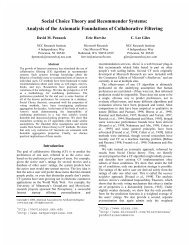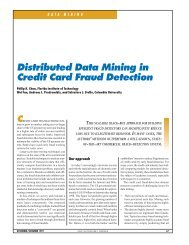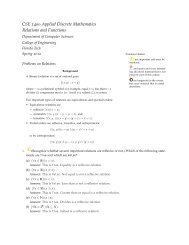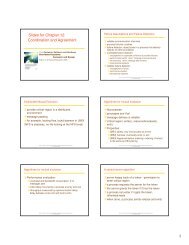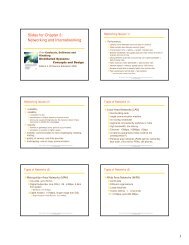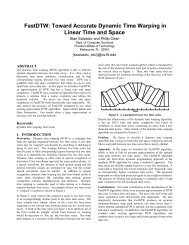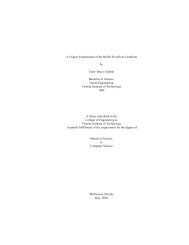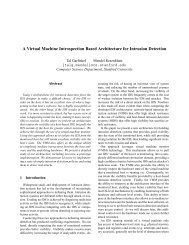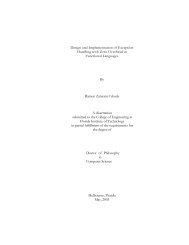Integration of Topological Constraints in Medical ... - Florent Ségonne
Integration of Topological Constraints in Medical ... - Florent Ségonne
Integration of Topological Constraints in Medical ... - Florent Ségonne
You also want an ePaper? Increase the reach of your titles
YUMPU automatically turns print PDFs into web optimized ePapers that Google loves.
This is page 1<br />
Pr<strong>in</strong>ter: Opaque this<br />
<strong>Integration</strong> <strong>of</strong> <strong>Topological</strong><br />
<strong>Constra<strong>in</strong>ts</strong> <strong>in</strong> <strong>Medical</strong> Image<br />
Segmentation<br />
F. Ségonne and B. Fischl 1<br />
ABSTRACT Topology is a strong global constra<strong>in</strong>t that can be useful <strong>in</strong><br />
generat<strong>in</strong>g geometrically accurate segmentations <strong>of</strong> anatomical structures.<br />
Conversely, topological “defects” or departures from the true topology <strong>of</strong><br />
a structure due to segmentation errors can greatly reduce the utility <strong>of</strong><br />
anatomical models. In this chapter we cover methods for <strong>in</strong>tegrat<strong>in</strong>g topological<br />
constra<strong>in</strong>ts <strong>in</strong>to segmentation procedures <strong>in</strong> order to generate geometrically<br />
accurate and topologically correct models, which is critical for<br />
many cl<strong>in</strong>ical and research applications.<br />
1 Introduction<br />
1.1 Description <strong>of</strong> the Problem<br />
In medical imag<strong>in</strong>g, the overall shape <strong>of</strong> a region <strong>of</strong> <strong>in</strong>terest is typically<br />
prescribed by medical knowledge; it is usually known a priori. Exclud<strong>in</strong>g<br />
pathological cases, the shape <strong>of</strong> most macroscopic bra<strong>in</strong> structures can be<br />
cont<strong>in</strong>uously deformed <strong>in</strong>to a sphere. In mathematical terms, these structures<br />
have the topology <strong>of</strong> a sphere. Particularly, this implies that most<br />
bra<strong>in</strong> structures consist <strong>of</strong> one s<strong>in</strong>gle connected object that does not possess<br />
any handles (i.e. holes) or cavities. This is the case for noncortical<br />
structures (such as left and right ventricle, putamen, pallidum, amygdala,<br />
hippocampus, thalamus, and caudate nucleus - see Fig. 1-a), but it also<br />
holds for the cortex under some specific conditions 2 . In addition to their<br />
<strong>in</strong>dividual topological properties, anatomical structures occur <strong>in</strong> a charac-<br />
1 Support for this research was provided <strong>in</strong> part by the National Center for Research<br />
Resources (P41-RR14075, R01 RR16594-01A1 and the NCRR BIRN Morphometric<br />
Project BIRN002, U24 RR021382), the National Institute for Biomedical Imag<strong>in</strong>g and<br />
Bioeng<strong>in</strong>eer<strong>in</strong>g (R01 EB001550, R01EB006758), the National Institute for Neurological<br />
Disorders and Stroke (R01 NS052585-01) as well as the Mental Illness and Neuroscience<br />
Discovery (MIND) Institute, and is part <strong>of</strong> the National Alliance for <strong>Medical</strong> Image<br />
Comput<strong>in</strong>g (NAMIC), funded by the National Institutes <strong>of</strong> Health through the NIH<br />
Roadmap for <strong>Medical</strong> Research, Grant U54 EB005149.<br />
2 The human cerebral cortex is a highly folded ribbon <strong>of</strong> gray matter (GM) that lies<br />
<strong>in</strong>side the cerebrosp<strong>in</strong>al fluid (CSF) and outside the white matter (WM) <strong>of</strong> the bra<strong>in</strong>.
2 F. Ségonne and B. Fischl<br />
FIGURE 1. a) Subcortical structures have a spherical topology. For <strong>in</strong>stance, the<br />
shape <strong>of</strong> the hippocampus can be cont<strong>in</strong>uously deformed onto a sphere. b) The<br />
human cerebral cortex is a highly folded ribbon <strong>of</strong> gray matter that lies <strong>in</strong>side<br />
the cerebrosp<strong>in</strong>al fluid (the red <strong>in</strong>terface) and outside the white matter <strong>of</strong> the<br />
bra<strong>in</strong> (the green <strong>in</strong>terface). When the midl<strong>in</strong>e connections between the left and<br />
right hemisphere are artificially closed, these two surfaces have the topology <strong>of</strong> a<br />
sphere. c) Due to the partial volume effect, subject motion, etc..., it becomes hard<br />
to dist<strong>in</strong>guish opposite banks <strong>of</strong> a the gray matter. d) Segmentation algorithms<br />
that do not constra<strong>in</strong> the topology <strong>of</strong>ten produce cortical segmentations with<br />
several topological defects (i.e. handles, cavities, disconnected components). e) A<br />
close-up <strong>of</strong> a topologically-<strong>in</strong>correct cortical surface representation.<br />
teristic spatial pattern relative to one another (e.g. <strong>in</strong> the human bra<strong>in</strong>, the<br />
amygdala is anterior and superior to the hippocampus). The set <strong>of</strong> <strong>in</strong>dividual<br />
topological properties and specific relationships between anatomical<br />
structures determ<strong>in</strong>e the global topology <strong>of</strong> a region <strong>of</strong> <strong>in</strong>terest.<br />
Although many cl<strong>in</strong>ical and research applications require accurate segmentations<br />
that respect the true anatomy <strong>of</strong> the targeted structures, only<br />
a few techniques have been proposed to achieve accurate and topologicallycorrect<br />
segmentations.<br />
1.2 Motivation<br />
Many neurodegenerative disorders, psychiatric disorders, and healthy ag<strong>in</strong>g<br />
are frequently associated with structural changes <strong>in</strong> the bra<strong>in</strong>. These<br />
changes, which can cause alterations <strong>in</strong> the imag<strong>in</strong>g properties <strong>of</strong> the bra<strong>in</strong><br />
tissue, as well as <strong>in</strong> morphometric properties <strong>of</strong> bra<strong>in</strong> structures, can be<br />
captured and detected by sophisticated segmentation techniques. Certa<strong>in</strong><br />
cl<strong>in</strong>ical and research applications depend crucially on the accuracy and correctness<br />
<strong>of</strong> the representations (visualization [11, 12, 56], spherical coord<strong>in</strong>ate<br />
system and surface-based atlases [12, 16, 17, 18, 22, 50, 56], shape analysis<br />
[16, 20, 31, 43, 53, 54], surface-based process<strong>in</strong>g <strong>of</strong> functional data [12],<br />
and <strong>in</strong>ter-subject registration [22, 51, 55], among others). Small geometric<br />
errors <strong>in</strong> a segmentation can easily change the apparent connectivity <strong>of</strong> the<br />
segmented structure, pos<strong>in</strong>g a problem to studies that aim at analyz<strong>in</strong>g<br />
Locally, its <strong>in</strong>tr<strong>in</strong>sic “unfolded” structure is that <strong>of</strong> a 2D sheet, several millimeters thick.<br />
In the absence <strong>of</strong> pathology and assum<strong>in</strong>g that the midl<strong>in</strong>e hemispheric connections are<br />
artificially closed, each cortical hemisphere can be considered as a simply-connected 2D<br />
sheet <strong>of</strong> neurons that carries the simple topology <strong>of</strong> a sphere - see Fig. 1-b
1. <strong>Integration</strong> <strong>of</strong> <strong>Topological</strong> <strong>Constra<strong>in</strong>ts</strong> <strong>in</strong> <strong>Medical</strong> Image Segmentation 3<br />
the connectedness <strong>of</strong> different regions (e.g. dramatic underestimation <strong>of</strong><br />
true geodesic distances). The accuracy and correctness <strong>of</strong> the representations<br />
can be critical factors <strong>in</strong> the success <strong>of</strong> studies <strong>in</strong>vestigat<strong>in</strong>g the subtle<br />
early effects <strong>of</strong> various disease processes.<br />
1.3 Challenges<br />
Accurate segmentation under anatomical consistency is challeng<strong>in</strong>g. Segmentation<br />
algorithms, which operate on the <strong>in</strong>tensity or texture variations<br />
<strong>of</strong> the image, are sensitive to the artifacts produced by the image acquisition<br />
process. These limitations <strong>in</strong>clude image noise, low frequency image<br />
<strong>in</strong>tensity variations or non-uniformity due to radio frequency (RF) <strong>in</strong>homogeneities,<br />
geometric distortions <strong>in</strong> the images, partial volume averag<strong>in</strong>g<br />
effect, and subject motion. Segmentation techniques that do not <strong>in</strong>tegrate<br />
any topological constra<strong>in</strong>ts generate segmentations that <strong>of</strong>ten conta<strong>in</strong> deviations<br />
from the true topology <strong>of</strong> the structures <strong>of</strong> <strong>in</strong>terest. These deviations<br />
are called topological defects and can be <strong>of</strong> three types: cavities, disconnected<br />
components, or handles (which are topologically equivalent to holes)<br />
that <strong>in</strong>correctly connect parts <strong>of</strong> the volumes.<br />
The <strong>in</strong>tegration <strong>of</strong> topological constra<strong>in</strong>ts significantly <strong>in</strong>creases the complexity<br />
<strong>of</strong> the task. Topology is both a global and a local concept; small and<br />
local modifications <strong>of</strong> a geometric shape can change its global connectivity.<br />
Furthermore, topology is <strong>in</strong>tr<strong>in</strong>sically a cont<strong>in</strong>uous concept (sec. 2.1)<br />
and topological notions are difficult to adapt <strong>in</strong>to a discrete framework<br />
(sec. 2.2). Due to these difficulties, the set <strong>of</strong> techniques applicable to the<br />
segmentation <strong>of</strong> images is quite limited (sec. 3).<br />
In this chapter, we present background material <strong>of</strong> central importance<br />
for the segmentation <strong>of</strong> medical images under topological constra<strong>in</strong>ts. We<br />
<strong>in</strong>troduce some elementary notions <strong>of</strong> topology (sec. 2.1) and show how<br />
these notions can be adapted <strong>in</strong>to a discrete framework and applied to the<br />
segmentation problem (sec. 2.2). Next, we describe the current state-<strong>of</strong>the-art<br />
segmentation <strong>of</strong> images under topological constra<strong>in</strong>ts (sec. 3) and<br />
detail the limitations <strong>of</strong> exist<strong>in</strong>g approaches (sec. 3). Section 4 concludes.<br />
2 Topology <strong>in</strong> <strong>Medical</strong> Imag<strong>in</strong>g<br />
In medical image segmentation, one is <strong>in</strong>terested <strong>in</strong> locat<strong>in</strong>g (accurately<br />
and also under topological constra<strong>in</strong>ts) specific regions <strong>of</strong> <strong>in</strong>terest that are<br />
formed by one or several anatomical structures. Those can be represented<br />
equivalently by their volume or their surface and these two equivalent representations<br />
correspond to the two most common data structures used <strong>in</strong><br />
medical imag<strong>in</strong>g: 3D voxel grids and surfaces (such as triangulations or<br />
levelsets).
4 F. Ségonne and B. Fischl<br />
2.1 General Notions <strong>of</strong> Topology<br />
Topology is a branch <strong>of</strong> mathematics that studies the properties <strong>of</strong> geometric<br />
figures by abstract<strong>in</strong>g their <strong>in</strong>herent connectivity while ignor<strong>in</strong>g their<br />
detailed form. The exact geometry <strong>of</strong> the objects, their location and the<br />
details <strong>of</strong> their shape are irrelevant to the study <strong>of</strong> their topological properties.<br />
Schematically, this amounts to characteriz<strong>in</strong>g a geometric object (i.e.<br />
a surface or a volume) by its number <strong>of</strong> disconnected components, holes<br />
and cavities, but not by their position. For <strong>in</strong>stance, the surface <strong>of</strong> a c<strong>of</strong>fee<br />
mug with a handle has the same topology as the surface <strong>of</strong> a doughnut<br />
(this type <strong>of</strong> surface is called a one-handled torus).<br />
FIGURE 2. a-b) Two tori that are homeomorphically equivalent. They share the<br />
same <strong>in</strong>tr<strong>in</strong>sic topology. However, they do not share the same homotopy type as<br />
one cannot be cont<strong>in</strong>uously transformed <strong>in</strong>to the other. c) A geometric object with<br />
a spherical topology; its Euler-characteristic is χ = v − e + f = 8 − 12 + 6 = 2.<br />
d) A geometric object with a toroidal topology and an Euler-characteristic <strong>of</strong><br />
χ = v − e + f = 16 − 32 + 16 = 0.<br />
A - Homeomorphism, Genus, and Euler-Characteristic<br />
In medical imag<strong>in</strong>g, the geometric entities under consideration are anatomical<br />
structures, which can frequently be advantageously represented by their<br />
surfaces. The Gauss-Bonnet theorem <strong>in</strong> differential geometry l<strong>in</strong>ks the geometry<br />
<strong>of</strong> surfaces with their topology. Any compact connected orientable<br />
surface is homeomorphic to a sphere with some number <strong>of</strong> handles. This<br />
number <strong>of</strong> handles is a topological <strong>in</strong>variant called the genus. For example,<br />
a sphere is <strong>of</strong> genus 0 and a torus is <strong>of</strong> genus 1. The genus g is directly<br />
related to another topological <strong>in</strong>variant called the Euler-characteristic χ<br />
by the formula χ = 2(1 − g) 3 . The Euler-characteristic is <strong>of</strong> great practical<br />
<strong>in</strong>terest because it can be calculated from any polyhedral decomposition<br />
(e.g. triangulation) <strong>of</strong> the surface by the simple formula χ = v−e+f, where<br />
v, e and f denote respectively the number <strong>of</strong> vertices, edges and faces <strong>of</strong><br />
the polyhedron. The Euler-characteristic <strong>of</strong> a sphere is χ = 2. This implies<br />
that any surface with χ = 2 is topologically equivalent (i.e. homeomorphic)<br />
to a sphere and therefore does not conta<strong>in</strong> any handles. Surfaces with an<br />
Euler-characteristic χ < 2 have a topology that is different from that <strong>of</strong> a<br />
3 In the case <strong>of</strong> multiple surfaces <strong>in</strong>volv<strong>in</strong>g K connected components, the total genus<br />
is related to the total Euler-characteristic by the formula: χ = 2(K − g).
1. <strong>Integration</strong> <strong>of</strong> <strong>Topological</strong> <strong>Constra<strong>in</strong>ts</strong> <strong>in</strong> <strong>Medical</strong> Image Segmentation 5<br />
sphere. Note, however, that the Euler-characteristic does not provide any<br />
<strong>in</strong>formation about the localization <strong>of</strong> the handles.<br />
B - Intr<strong>in</strong>sic Topology and Homotopy Type<br />
Homeomorphisms are used to def<strong>in</strong>e the <strong>in</strong>tr<strong>in</strong>sic topology <strong>of</strong> an object,<br />
<strong>in</strong>dependently <strong>of</strong> the embedd<strong>in</strong>g space. The topological <strong>in</strong>variance <strong>of</strong> the<br />
Euler characteristic implies that the way a surface is decomposed (i.e. tessellated)<br />
does not <strong>in</strong>fluence its (<strong>in</strong>tr<strong>in</strong>sic) topology. Any polyhedral decomposition<br />
<strong>of</strong> a surface will encode the same <strong>in</strong>tr<strong>in</strong>sic topology. For example, a<br />
knotted solid torus has the same genus (and the same Euler-characteristic<br />
χ = 0) as a simple torus. In order to topologically differentiate surfaces, one<br />
needs a theory that considers the embedd<strong>in</strong>g space. Homotopy, which def<strong>in</strong>es<br />
two surfaces to be homotopic if one can be cont<strong>in</strong>uously transformed<br />
<strong>in</strong>to the other, is such a theory that provides a measure <strong>of</strong> an object’s<br />
topology (see [8] for an excellent course <strong>in</strong> algebraic topology). We stress<br />
the fact that the Euler-characteristic does not def<strong>in</strong>e the homotopy type <strong>of</strong><br />
a surface, s<strong>in</strong>ce the embedd<strong>in</strong>g space is be<strong>in</strong>g ignored. In particular, this<br />
implies that a discrete representation <strong>of</strong> a surface us<strong>in</strong>g a polygonal decomposition<br />
with the desired Euler-characteristic might be self-<strong>in</strong>tersect<strong>in</strong>g <strong>in</strong><br />
the 3D embedd<strong>in</strong>g space (Fig 3).<br />
FIGURE 3. a) a simple closed curve with the topology <strong>of</strong> a circle. b) One example<br />
<strong>of</strong> a polyhedral decomposition <strong>of</strong> the curve us<strong>in</strong>g 25 vertices and edges.<br />
The correspond<strong>in</strong>g Euler-characteristic χ = v − e = 0 is that <strong>of</strong> a circle. c) Another<br />
discretization <strong>of</strong> the same curve us<strong>in</strong>g 14 edges and vertices. Note that the<br />
Euler-characteristic is still that <strong>of</strong> a circle χ = 0, even though the discrete representation<br />
<strong>of</strong> the curve self-<strong>in</strong>tersects <strong>in</strong> the 2D embedd<strong>in</strong>g space. d) Close-up.<br />
C - <strong>Topological</strong> Defects, Duality Foreground/Background<br />
In this chapter, we call topological defect any deviation from spherical<br />
topology: cavities, disconnected components, or handles. We note that for<br />
each defect present <strong>in</strong> a geometric entity, referred to as the foreground<br />
object, there exists a correspond<strong>in</strong>g defect <strong>in</strong> the background (i.e. the embedd<strong>in</strong>g<br />
space): a disconnected foreground component can be <strong>in</strong>terpreted<br />
as a background cavity; a foreground cavity is a disconnected background<br />
component; and a handle <strong>in</strong> a foreground component def<strong>in</strong>es another handle<br />
<strong>in</strong> the background component. This foreground/background duality is<br />
<strong>of</strong> crucial importance for all retrospective topology correction techniques,<br />
as it provides a dual methodology to correct a topological defect. For <strong>in</strong>-
6 F. Ségonne and B. Fischl<br />
stance, the presence <strong>of</strong> a handle <strong>in</strong> an object could be corrected by either<br />
cutt<strong>in</strong>g the handle <strong>in</strong> the foreground object, or cutt<strong>in</strong>g the correspond<strong>in</strong>g<br />
handle <strong>in</strong> the background object. Cutt<strong>in</strong>g the background handle can be<br />
<strong>in</strong>terpreted as fill<strong>in</strong>g the correspond<strong>in</strong>g foreground hole (Fig. 4-b,c).<br />
2.2 Topology and Discrete Imag<strong>in</strong>g<br />
In order to apply topological concepts to a discrete framework and def<strong>in</strong>e<br />
the topology type (i.e. homotopy type) <strong>of</strong> digital segmentations, the notion<br />
<strong>of</strong> cont<strong>in</strong>uity must be adapted to discrete spaces and objects, such as 3D<br />
image grids and triangulations. This is obta<strong>in</strong>ed by replac<strong>in</strong>g the notion <strong>of</strong><br />
cont<strong>in</strong>uity with the weaker notion <strong>of</strong> connectivity. We describe how topological<br />
notions can be adapted to the two most common data structures<br />
used <strong>in</strong> medical imag<strong>in</strong>g: 3D data structures and surfaces.<br />
A - Digital Topology<br />
Digital topology provides an elegant framework, which translates the cont<strong>in</strong>uous<br />
concepts <strong>of</strong> topology to discrete images. In this theory, b<strong>in</strong>ary images<br />
<strong>in</strong>herit a precise topological mean<strong>in</strong>g. In particular, the concept <strong>of</strong><br />
homotopic deformation, which is required to assign a topological type to<br />
a digital object, is clearly def<strong>in</strong>ed through the notion <strong>of</strong> simple po<strong>in</strong>t. An<br />
extensive discussion <strong>of</strong> these concepts can be found <strong>in</strong> [36]. In this section,<br />
some basic notions <strong>of</strong> digital topology are presented. All def<strong>in</strong>itions are<br />
from the work <strong>of</strong> G. Bertrand, which we refer to for more details [7].<br />
FIGURE 4. a) 6-, 18- and 26-connectivity. b) The circled voxel is a non-simple<br />
po<strong>in</strong>t c) Several dual topological corrections are possible: either cutt<strong>in</strong>g the handle<br />
(top) or fill<strong>in</strong>g the hole (bottom).<br />
In the digital topology framework, a 3D image I is <strong>in</strong>terpreted as a<br />
graph. The vertices <strong>of</strong> the graph are the digital po<strong>in</strong>ts (i.e. the voxels) and<br />
the edges are def<strong>in</strong>ed through neighborhood relations between po<strong>in</strong>ts (i.e.<br />
the connectivity). A 3D b<strong>in</strong>ary digital image I is composed <strong>of</strong> a foreground<br />
object X and its <strong>in</strong>verse, the complement X. We first need to def<strong>in</strong>e the<br />
concept <strong>of</strong> connectivity, which specifies the condition <strong>of</strong> adjacency that two<br />
po<strong>in</strong>ts must fulfill to be regarded as connected. Three types <strong>of</strong> connectivity<br />
are commonly used <strong>in</strong> 3D: 6-, 18- and 26-connectivity. Two voxels are 6-<br />
adjacent if they share a face, 18-adjacent if they share at least an edge and<br />
26-adjacent if they share at least a corner (Fig. 4-a). In order to avoid topological<br />
paradoxes, different connectivities, n and n, must be used for one
1. <strong>Integration</strong> <strong>of</strong> <strong>Topological</strong> <strong>Constra<strong>in</strong>ts</strong> <strong>in</strong> <strong>Medical</strong> Image Segmentation 7<br />
digital object X and its complement X. This leaves us with four pairs <strong>of</strong><br />
compatible connectivities: (6,26), (6,18), (26,6) and (18,6). One important<br />
consequence <strong>of</strong> the previous requirement is that digital topology does not<br />
provide a consistent framework for multi-label images. No compatible connectivities<br />
can be chosen for neighbor<strong>in</strong>g components <strong>of</strong> the same object.<br />
Therefore, digital topology is strictly limited to b<strong>in</strong>ary images.<br />
We now come to the def<strong>in</strong>ition <strong>of</strong> a simple po<strong>in</strong>t. This concept is central to<br />
most digital segmentation methods that <strong>in</strong>tegrate topological constra<strong>in</strong>ts [3,<br />
26, 32, 36, 42, 44, 49].<br />
Def<strong>in</strong>ition 1.1 Simple po<strong>in</strong>t A po<strong>in</strong>t <strong>of</strong> a b<strong>in</strong>ary object is simple if it can<br />
be added or removed without chang<strong>in</strong>g the topology <strong>of</strong> both the object and the<br />
background, that is, without chang<strong>in</strong>g the number <strong>of</strong> connected components,<br />
cavities and handles <strong>of</strong> both X and X (Fig. 4-b,c).<br />
A simple po<strong>in</strong>t is easily characterized by two topological numbers with respect<br />
to the digital object (X, X) and a consistent connectivity pair (n, n).<br />
These numbers, denoted T n (x, X) and T n (x, X), were <strong>in</strong>troduced by G.<br />
Bertrand <strong>in</strong> [1] as an elegant way to classify the topology type <strong>of</strong> a given<br />
voxel. The values <strong>of</strong> T n (x, X) and T n (x, X) characterize isolated, <strong>in</strong>terior<br />
and border po<strong>in</strong>ts as well as different k<strong>in</strong>ds <strong>of</strong> junctions. In particular, a<br />
po<strong>in</strong>t is simple if and only if T n (x, X) = T n (x, X) = 1. Their efficient<br />
computation, which only <strong>in</strong>volves the 26-neighborhood, is described <strong>in</strong> [6].<br />
The def<strong>in</strong>ition <strong>of</strong> a discrete homotopy follows from the concept <strong>of</strong> simple<br />
po<strong>in</strong>t.<br />
Def<strong>in</strong>ition 1.2 Homotopic deformation We def<strong>in</strong>e a homotopic deformation<br />
<strong>of</strong> an object X as a sequence <strong>of</strong> deletions or additions <strong>of</strong> simple<br />
po<strong>in</strong>ts.<br />
F<strong>in</strong>ally, two objects X and Y share the same homotopy type if there exists<br />
a sequence <strong>of</strong> transformations X 0 ...X k and a sequence <strong>of</strong> po<strong>in</strong>ts x 1 ...x k ,<br />
such that X 0 = X and X i−1 = X i<br />
⋃ {xi } or X i−1 = X i \ {x i } and the<br />
po<strong>in</strong>t x i is simple relative to X i for i = 1, ..., k.<br />
To be complete, we also mention some recent research <strong>in</strong> digital topology,<br />
such as the concept <strong>of</strong> multisimple po<strong>in</strong>t <strong>in</strong> [45, 44] to characterize<br />
the modification <strong>of</strong> the genus, a novel characterization <strong>of</strong> homeomorphic<br />
deformation <strong>in</strong> [4], as well as some octree grid topology concept <strong>in</strong> [1].<br />
B - Surfaces <strong>in</strong> Discrete Imag<strong>in</strong>g<br />
We now turn to the translation <strong>of</strong> cont<strong>in</strong>uous topological concepts to discrete<br />
surface representations. There are essentially two ways <strong>of</strong> represent<strong>in</strong>g<br />
a surface <strong>in</strong> discrete imag<strong>in</strong>g. Surfaces can be either represented explicitly,<br />
by us<strong>in</strong>g a parameterized polygonal decomposition, or implicitly as the<br />
level set <strong>of</strong> some function def<strong>in</strong>ed <strong>in</strong> the 3D embedd<strong>in</strong>g space. Each type <strong>of</strong><br />
representation has advantages and disadvantages, and has been extensively<br />
used for the purpose <strong>of</strong> medical image segmentation [11, 13, 21, 23, 35, 37,<br />
57, 58, 59].
8 F. Ségonne and B. Fischl<br />
FIGURE 5. a) A triangulated cortical surface b) Til<strong>in</strong>g <strong>in</strong>conscistency <strong>in</strong> isosurface<br />
extraction c) Different tessellations correspond<strong>in</strong>g to different topology<br />
types.<br />
B.1 - Explicit Representations<br />
An explicit representation models a surface by a set <strong>of</strong> vertices, edges, and<br />
faces, associated with a chosen parameterization <strong>of</strong> each face. The set <strong>of</strong><br />
vertices, edges, and faces composes the polyhedral representation <strong>of</strong> the<br />
surface. The parameterization <strong>of</strong> the faces determ<strong>in</strong>es the exact geometry<br />
<strong>of</strong> the surface. For <strong>in</strong>stance, tessellations correspond to l<strong>in</strong>ear parameterizations<br />
<strong>of</strong> each face, while spl<strong>in</strong>es use higher-order approximations. Triangulations<br />
are a special k<strong>in</strong>d <strong>of</strong> tessellation, <strong>in</strong> which each face is a triangle<br />
(Fig. 5-a).<br />
The topological <strong>in</strong>variance <strong>of</strong> the Euler-characteristic implies that explicit<br />
models unambiguously encode the <strong>in</strong>tr<strong>in</strong>sic topology <strong>of</strong> the surfaces.<br />
However, there is no guarantee that the surface representation is not self<strong>in</strong>tersect<strong>in</strong>g.<br />
As previously mentioned, the topological equivalence def<strong>in</strong><strong>in</strong>g<br />
the <strong>in</strong>tr<strong>in</strong>sic topology <strong>of</strong> a geometric entity ignores the embedd<strong>in</strong>g space.<br />
Consequently, additional precautions must be taken <strong>in</strong> order to ensure<br />
that the discretization <strong>of</strong> a surface does not generate self-<strong>in</strong>tersections.<br />
The self-<strong>in</strong>tersection problem is important when the surfaces are iteratively<br />
deformed <strong>in</strong> order to match a targeted structure (i.e. theory <strong>of</strong> active<br />
contours).<br />
F<strong>in</strong>ally, we note that explicit representations can approximate surfaces<br />
at any level <strong>of</strong> precision, by us<strong>in</strong>g more ref<strong>in</strong>ed meshes. Contrary to the<br />
theory <strong>of</strong> digital topology that constitutes a discrete approximation <strong>of</strong> the<br />
cont<strong>in</strong>uous space, and is therefore limited by the resolution <strong>of</strong> the 3D digital<br />
images, explicit representations can accurately approximate any surface by<br />
us<strong>in</strong>g high-resolution meshes.<br />
B.2 - Implicit Representations<br />
Implicit models encode the surface <strong>of</strong> <strong>in</strong>terest C as the level set <strong>of</strong> a higherdimensional<br />
function φ def<strong>in</strong>ed <strong>in</strong> the embedd<strong>in</strong>g space R 3 . The function<br />
φ, def<strong>in</strong>ed on a 3D voxel grid, is usually the signed distance function <strong>of</strong> the<br />
surface with the contour be<strong>in</strong>g the zero level set <strong>of</strong> φ: C = φ −1 (0).<br />
This type <strong>of</strong> representation has several advantages. First, no explicit representation<br />
and no parameterization are required. In the theory <strong>of</strong> active<br />
contours, this has proven to be a huge advantage as implicit representations<br />
can naturally change topology dur<strong>in</strong>g the deformation <strong>of</strong> the model. Self<strong>in</strong>tersections,<br />
which are costly to prevent <strong>in</strong> parametric deformable models,<br />
are avoided and topological changes are automated. In addition, many fun-
1. <strong>Integration</strong> <strong>of</strong> <strong>Topological</strong> <strong>Constra<strong>in</strong>ts</strong> <strong>in</strong> <strong>Medical</strong> Image Segmentation 9<br />
damental properties <strong>of</strong> the surface C, such as its normal or its curvature,<br />
are easily computed from the level set function φ.<br />
However, these models can only represent manifolds <strong>of</strong> codimension one<br />
without borders, i.e. closed surfaces <strong>in</strong> R 3 . For the purpose <strong>of</strong> segment<strong>in</strong>g<br />
anatomical structures, the use <strong>of</strong> such representations is not a limitation.<br />
Another - more subtle - drawback <strong>of</strong> implicit representations is that, even<br />
though level sets achieve sub-voxel accuracy, the exact location <strong>of</strong> the contour<br />
depends on the image resolution. For <strong>in</strong>stance, <strong>in</strong> the case <strong>of</strong> two<br />
adjacent banks <strong>of</strong> a sulcus that are closer than the resolution <strong>of</strong> the underly<strong>in</strong>g<br />
voxel grid (or physically touch<strong>in</strong>g), the f<strong>in</strong>ite image resolution and<br />
the topological constra<strong>in</strong>t necessitate some voxels to be labeled as outside<br />
voxels (ideally, these voxels should be the ones belong<strong>in</strong>g to CSF), thus impos<strong>in</strong>g<br />
a constra<strong>in</strong>t on the location and accuracy <strong>of</strong> the surface model (some<br />
recent methods to alleviate this limitation have been proposed <strong>in</strong> [2, 27]).<br />
So far, we have not specified how implicit representations can ensure<br />
that the topology <strong>of</strong> the encoded surface is the correct one. S<strong>in</strong>ce implicit<br />
representations make use <strong>of</strong> the underly<strong>in</strong>g 3D voxel grid (through a signed<br />
distance function φ) to encode the contour <strong>of</strong> <strong>in</strong>terest, digital topology<br />
(sec. 2.2-A) can be used to specify the topology <strong>of</strong> the contour [28]. The<br />
foreground object X is simply def<strong>in</strong>ed as the set <strong>of</strong> negative grid po<strong>in</strong>ts<br />
(i.e. X = {x ∈ R 3 | φ(x) ≤ 0}), and the background object X as the<br />
set <strong>of</strong> strictly positive grid po<strong>in</strong>ts (i.e. X = {x ∈ R 3 | φ(x) > 0}). Then,<br />
given a choice <strong>of</strong> compatible connectivities, the topology <strong>of</strong> the contour is<br />
determ<strong>in</strong>ed unambiguously.<br />
C - From Images to Surfaces: Isocontour Extraction<br />
In the previous section, we described the manner <strong>in</strong> which topology can be<br />
adapted to the two most common data structures used <strong>in</strong> medical imag<strong>in</strong>g.<br />
The ability to go from one representation to the next arises as a difficulty.<br />
Although it is possible to generate triangulations from 3D b<strong>in</strong>ary digital<br />
segmentations, such that the result<strong>in</strong>g topology <strong>of</strong> the surfaces is consistent<br />
with the choice <strong>of</strong> digital topology, it is not always possible to produce a<br />
digital b<strong>in</strong>ary representation, whose topology is similar to that <strong>of</strong> a given<br />
triangulation: digital topology constitutes a discrete approximation <strong>of</strong> the<br />
cont<strong>in</strong>uous space at a f<strong>in</strong>ite resolution, while triangulations approximate<br />
cont<strong>in</strong>uous surfaces at any level <strong>of</strong> precision.<br />
The march<strong>in</strong>g cubes (MC) algorithm was first <strong>in</strong>troduced by Lorensen<br />
and Cl<strong>in</strong>e <strong>in</strong> 1987 [34] as a way to generate a polygonal decomposition (e.g.<br />
a triangulation) from a scalar field sampled on a rectil<strong>in</strong>ear grid (e.g. an implicit<br />
representation). Given an isovalue, the MC algorithm quickly extracts<br />
a representation <strong>of</strong> the isosurface <strong>of</strong> the scalar field. The MC algorithm first<br />
partitions the data <strong>in</strong>to a set <strong>of</strong> cubic (or rectil<strong>in</strong>ear) cells, the cell vertices<br />
be<strong>in</strong>g the grid po<strong>in</strong>ts. Based on the relative polarity <strong>of</strong> their scalar value<br />
(above or below the isovalue), each vertex is assigned a b<strong>in</strong>ary label, which<br />
<strong>in</strong>dicates whether the grid po<strong>in</strong>t is <strong>in</strong>side or outside the isosurface. Then,
10 F. Ségonne and B. Fischl<br />
each cubic cell is processed sequentially. Patches (i.e. sets <strong>of</strong> triangles) that<br />
approximate the isosurface (based on tri-l<strong>in</strong>ear <strong>in</strong>terpolation) are produced<br />
with<strong>in</strong> each cube, and the polygon patches are naturally jo<strong>in</strong>ed together to<br />
form the f<strong>in</strong>al isosurface representation.<br />
Unfortunately, the standard march<strong>in</strong>g squares or march<strong>in</strong>g cubes algorithm<br />
does not generate topologically consistent tessellations, s<strong>in</strong>ce the<br />
result<strong>in</strong>g tessellations may conta<strong>in</strong> til<strong>in</strong>g and topological <strong>in</strong>consistencies<br />
(Fig. 5-b). In order to alleviate this problem, Han et al. [28] have designed<br />
a modified connectivity-consistent march<strong>in</strong>g contour algorithm, by build<strong>in</strong>g<br />
a specialized case table for each type <strong>of</strong> digital topology (Fig. 5-c).<br />
Extensive discussion <strong>of</strong> isocontour extraction algorithms can be found <strong>in</strong><br />
the thesis <strong>of</strong> Han [25]. Note also some new research directions such as [1].<br />
3 State <strong>of</strong> the Art <strong>in</strong> Segmentation under<br />
<strong>Topological</strong> <strong>Constra<strong>in</strong>ts</strong><br />
As noted previously, methods for produc<strong>in</strong>g topologically-correct segmentations<br />
can be broadly divided <strong>in</strong>to two categories. A first set <strong>of</strong> approaches<br />
directly <strong>in</strong>corporates topological constra<strong>in</strong>ts <strong>in</strong>to the segmentation process,<br />
while another set aims at correct<strong>in</strong>g retrospectively the spherical topology<br />
<strong>of</strong> an already segmented image.<br />
3.1 <strong>Topological</strong>ly-Constra<strong>in</strong>ed Segmentations<br />
The topology-enforc<strong>in</strong>g techniques proceed by iteratively deform<strong>in</strong>g a model<br />
<strong>of</strong> known topology onto a targeted structure, while preserv<strong>in</strong>g its topology.<br />
Several techniques have been used for the segmentation <strong>of</strong> anatomical structures,<br />
with the topological constra<strong>in</strong>t tak<strong>in</strong>g different forms depend<strong>in</strong>g on<br />
the chosen method.<br />
A - Active Contours<br />
Depend<strong>in</strong>g on the representation, two different implementations are usually<br />
encountered. One encodes the manifold <strong>of</strong> <strong>in</strong>terest with an explicit<br />
representation us<strong>in</strong>g a Lagrangian formulation [52], while another implicitly<br />
represents the contour as the level set <strong>of</strong> a function def<strong>in</strong>ed on higherdimensional<br />
manifold <strong>in</strong> an Eulerian formulation [9, 40].<br />
• Parameterized models ma<strong>in</strong>ta<strong>in</strong> an explicit representation <strong>of</strong> the contour<br />
and preserve its <strong>in</strong>itial <strong>in</strong>tr<strong>in</strong>sic topology. Any level <strong>of</strong> accuracy can<br />
be achieved by us<strong>in</strong>g more ref<strong>in</strong>ed meshes. However, the preservation <strong>of</strong><br />
the whole topology also requires the prevention <strong>of</strong> self-<strong>in</strong>tersections, which<br />
proves to be computationally <strong>in</strong>tensive and requires elaborate methods to<br />
detect and prevent surface <strong>in</strong>tersection dur<strong>in</strong>g the evolution. Also, note that<br />
the preservation <strong>of</strong> the <strong>in</strong>itial topology is <strong>of</strong>ten a strong limitation to most
1. <strong>Integration</strong> <strong>of</strong> <strong>Topological</strong> <strong>Constra<strong>in</strong>ts</strong> <strong>in</strong> <strong>Medical</strong> Image Segmentation 11<br />
explicit models, s<strong>in</strong>ce a fully automatic and efficient handl<strong>in</strong>g <strong>of</strong> topology<br />
changes us<strong>in</strong>g explicit models rema<strong>in</strong>s an open issue [14, 15, 33, 41, 38, 39].<br />
• The ability to automatically handle topological changes is a long acknowledged<br />
advantage <strong>of</strong> the level set method over explicit deformable<br />
models, but may not be desirable <strong>in</strong> some applications where some prior<br />
knowledge <strong>of</strong> the target topology is available. This is typically the case <strong>in</strong><br />
biomedical image segmentation, where the topology <strong>of</strong> the organs and their<br />
mutual topological relations is prescribed by anatomical knowledge (<strong>in</strong> the<br />
absence <strong>of</strong> gross pathology). In order to overcome this problem, a topologypreserv<strong>in</strong>g<br />
variant <strong>of</strong> the level set method has been proposed <strong>in</strong> [28]. This<br />
method is based on the theory <strong>of</strong> digital topology and uses the underly<strong>in</strong>g<br />
embedd<strong>in</strong>g space to constra<strong>in</strong> the topology <strong>of</strong> the <strong>in</strong>terior <strong>of</strong> the level set.<br />
However, the strict topology preservation necessitates an <strong>in</strong>itialization <strong>of</strong><br />
the active contour that is close to its f<strong>in</strong>al configuration <strong>in</strong> order to avoid<br />
topological barriers that can easily generate large geometrical errors. In<br />
the case <strong>of</strong> complex structures, like the cortical surface, such <strong>in</strong>itialization<br />
proves to be extremely difficult [26].<br />
Recently, another variant was proposed to exert a more subtle topological<br />
control on a level set evolution by allow<strong>in</strong>g connected components to merge,<br />
split or vanish without chang<strong>in</strong>g the genus <strong>of</strong> the active contours [44].<br />
While the orig<strong>in</strong>al level set model does not provide any topological control,<br />
topology-preserv<strong>in</strong>g level sets enforce a strong constra<strong>in</strong>t that is <strong>of</strong>ten too<br />
restrictive. This framework establishes a trade-<strong>of</strong>f between the two models.<br />
It <strong>of</strong>fers a more f<strong>in</strong>e-gra<strong>in</strong>ed topological control that alleviates many problems<br />
<strong>of</strong> methods that enforce a strong topological constra<strong>in</strong>t (e.g. sensitivity<br />
to <strong>in</strong>itialization and noise, simultaneous evolution <strong>of</strong> multiple components<br />
and speed <strong>of</strong> convergence).<br />
B - Digital Homotopic Deformations<br />
Similar to active contour models, digital approaches [8, 3, 5, 36, 42] deform<br />
an <strong>in</strong>itial region with a known given topology (typically a s<strong>in</strong>gle voxel<br />
carry<strong>in</strong>g a spherical topology), by addition/deletion <strong>of</strong> po<strong>in</strong>ts, m<strong>in</strong>imiz<strong>in</strong>g<br />
a global energy functional while preserv<strong>in</strong>g the correct digital topology.<br />
Regions are grown or shrunk by add<strong>in</strong>g po<strong>in</strong>ts that will not change the<br />
region topology. Most <strong>of</strong> these methods are based on the theory <strong>of</strong> digital<br />
topology and the notion <strong>of</strong> simple po<strong>in</strong>ts.<br />
C - Segmentation by Registration<br />
Some approaches have been proposed to match a template with a given<br />
topology onto a specified MRI image [3, 10, 30]. These methods have the<br />
strong advantage <strong>of</strong> be<strong>in</strong>g able to enforce complex topology <strong>in</strong> the segmentation<br />
process, and to encode the spatial relationships that exist <strong>in</strong><br />
between structures [4, 5]. Nevertheless, the design <strong>of</strong> elaborate templates<br />
that <strong>in</strong>clude several structures with the correct topology is challeng<strong>in</strong>g.
12 F. Ségonne and B. Fischl<br />
D - Limitations <strong>of</strong> <strong>Topological</strong>ly-Constra<strong>in</strong>ed Segmentations<br />
All these methods have the advantage <strong>of</strong> allow<strong>in</strong>g the user to specify the<br />
proper topology and not allow<strong>in</strong>g it to change. In the case <strong>of</strong> segmentation<br />
by registration, full bra<strong>in</strong> models conta<strong>in</strong><strong>in</strong>g several structures can be<br />
matched onto a targeted image. Unfortunately, these methods are highly<br />
sensitive with regard to their <strong>in</strong>itialization, and accurate f<strong>in</strong>al configurations<br />
most <strong>of</strong>ten require an <strong>in</strong>itialization <strong>of</strong> the models that is close to its<br />
f<strong>in</strong>al configuration. One <strong>of</strong> the ma<strong>in</strong> reasons is that the energy functionals<br />
driv<strong>in</strong>g the deformation are typically highly non-convex and the evolution<br />
is therefore easily trapped <strong>in</strong> local m<strong>in</strong>ima.<br />
A significant drawback <strong>of</strong> topologically constra<strong>in</strong>ed evolution is that it<br />
can lead to large geometric errors, due to the topological constra<strong>in</strong>t and the<br />
presence <strong>of</strong> topological barriers (constituted by sets <strong>of</strong> non-simple po<strong>in</strong>ts <strong>in</strong><br />
the case <strong>of</strong> digital segmentations, self-touch<strong>in</strong>g and frozen surface regions<br />
<strong>in</strong> active contours segmentations). This is the case for methods that aim at<br />
segment<strong>in</strong>g the cortex start<strong>in</strong>g from one s<strong>in</strong>gle object located deep <strong>in</strong>side<br />
the cortical surface. Large topological barriers are <strong>of</strong>ten generated dur<strong>in</strong>g<br />
the template deformation lead<strong>in</strong>g to <strong>in</strong>accurate f<strong>in</strong>al segmentations. This<br />
is mostly a result <strong>of</strong> the presence <strong>of</strong> noise <strong>in</strong> the image and <strong>of</strong> the fact that<br />
topologically constra<strong>in</strong>ed segmentation prevents the formation <strong>of</strong> cavities<br />
(easy to detect and suppress) as well as the formation <strong>of</strong> handles.<br />
F<strong>in</strong>ally, we note that digital methods, as well as implicit representations<br />
that use the 3D embedd<strong>in</strong>g space to encode the surface <strong>of</strong> <strong>in</strong>terest, are<br />
constra<strong>in</strong>ed by the f<strong>in</strong>ite resolution <strong>of</strong> the 3D grid and may not be able to<br />
represent deep folds <strong>in</strong> the target structure. To solve this problem, Han et<br />
al. [27] have implemented a mov<strong>in</strong>g grid algorithm, which aims at optimally<br />
deform<strong>in</strong>g the underly<strong>in</strong>g 3D grid for accurate implicit representations. Let<br />
us also mention some recent octree-based topology-preserv<strong>in</strong>g geometric<br />
deformable model [2].<br />
3.2 Retrospective Topology Correction<br />
Recently, new approaches have been developed to retrospectively correct<br />
the topology <strong>of</strong> an already-segmented image. These techniques, which do<br />
not impose any topological constra<strong>in</strong>ts on the segmentation process, can<br />
focus on atta<strong>in</strong><strong>in</strong>g more accurate models with few topological <strong>in</strong>consistencies<br />
to be identified and corrected post-hoc. These methods can be divided<br />
<strong>in</strong>to two ma<strong>in</strong> classes: volume-based methods that work directly on<br />
the volume lattice and correct the topology by addition/deletion <strong>of</strong> voxels<br />
[26, 32, 46, 49], and surface-based methods that aim at modify<strong>in</strong>g the<br />
tessellation by locat<strong>in</strong>g and cutt<strong>in</strong>g handles [19, 24, 47, 48].<br />
A - Volume-Based Approaches<br />
Most volume-based approaches have been specifically designed to enforce<br />
the spherical topology <strong>of</strong> cortical surface. These methods identify the lo-
1. <strong>Integration</strong> <strong>of</strong> <strong>Topological</strong> <strong>Constra<strong>in</strong>ts</strong> <strong>in</strong> <strong>Medical</strong> Image Segmentation 13<br />
cation <strong>of</strong> the topological defects present <strong>in</strong> the segmentation by build<strong>in</strong>g a<br />
graph encod<strong>in</strong>g the connectivity <strong>of</strong> the segmentation; the topological defects<br />
present <strong>in</strong> the volume are then corrected by <strong>in</strong>troduc<strong>in</strong>g some cuts <strong>in</strong><br />
the connectivity graph (e.g. modify<strong>in</strong>g the b<strong>in</strong>ary labels <strong>of</strong> some key voxels<br />
<strong>in</strong> the volume).<br />
One <strong>of</strong> the most <strong>in</strong>spirational approaches <strong>in</strong> this doma<strong>in</strong> is certa<strong>in</strong>ly the<br />
pioneer<strong>in</strong>g work <strong>of</strong> Shattuck and Leahy [49]. One drawback <strong>of</strong> their approach<br />
is that the “cuts”, which are necessary to correct the topological<br />
defects, can only be oriented along the Cartesian axes and give rise to “unnatural”<br />
topological corrections. Their method is based on the theory <strong>of</strong><br />
digital topology but is limited to 6-connectivity and has not been generalized<br />
for any other connectivity rule.<br />
Han et al. developed an algorithm to correct the topology <strong>of</strong> a b<strong>in</strong>ary<br />
object under any digital connectivity [26]. They detect handles by graph<br />
analysis, us<strong>in</strong>g successive foreground and background morphological open<strong>in</strong>gs<br />
to iteratively break the potential topological defects at the smallest<br />
scales. In contrast to the approach <strong>of</strong> Shattuck and Leahy, “cuts” are not<br />
forced to be oriented along card<strong>in</strong>al axes. However, topological corrections<br />
at a specific scale depend on the choice <strong>of</strong> filter, either foreground or background<br />
morphological filter, which fails to evaluate simultaneously the effect<br />
<strong>of</strong> two complementary dual solutions (i.e. cutt<strong>in</strong>g the handle or fill<strong>in</strong>g<br />
the correspond<strong>in</strong>g hole) on the corrected segmentation.<br />
Kriegeskorte and Goeble proposed a region grow<strong>in</strong>g method prioritized<br />
by the distance-to-surface <strong>of</strong> the voxels <strong>in</strong> order to force the cuts to be located<br />
at the th<strong>in</strong>nest part <strong>of</strong> each topological defect [32]. The same process<br />
is applied to the <strong>in</strong>verse object, <strong>of</strong>fer<strong>in</strong>g an alternative solution to each cut.<br />
An empirical cost is then assigned to each solution and the f<strong>in</strong>al decision<br />
is the one m<strong>in</strong>imiz<strong>in</strong>g the global cost function.<br />
While these methods can be effective, they cannot be used to correct the<br />
topology <strong>of</strong> arbitrary segmentations, as they make assumptions regard<strong>in</strong>g<br />
the topology <strong>of</strong> the <strong>in</strong>itial <strong>in</strong>put image. Most frequently, fully-connected<br />
volumes are assumed and cavities are supposed to be removed as a preprocess<strong>in</strong>g<br />
step. In addition, they do not <strong>in</strong>tegrate any statistical or geometric<br />
<strong>in</strong>formation <strong>in</strong>to the topology correction process. To alleviate these limitations,<br />
Ségonne et al. [46, 45] propose a topology correction approach that is<br />
phrased with<strong>in</strong> the theory <strong>of</strong> Bayesian parameter estimation and <strong>in</strong>tegrates<br />
statistical <strong>in</strong>formation <strong>in</strong>to the topology correction process. In addition, no<br />
assumption is made about the topology <strong>of</strong> the <strong>in</strong>itial <strong>in</strong>put images.<br />
B - Surface-Based Approaches<br />
Approaches <strong>of</strong> the other type operate directly on the triangulated surface<br />
mesh. <strong>Topological</strong> defects are located either as <strong>in</strong>tersections <strong>of</strong> wavefronts<br />
propagat<strong>in</strong>g on the tessellation [24, 29] or as non-homeomorphic regions<br />
between the <strong>in</strong>itial triangulation and a sphere [19, 47, 48].<br />
In [24, 29], a randomly selected vertex is used to <strong>in</strong>itialize a region
14 F. Ségonne and B. Fischl<br />
grow<strong>in</strong>g algorithm, which detects loops (i.e. topological defects) <strong>in</strong> the triangulation<br />
where wavefronts meet. <strong>Topological</strong> corrections are obta<strong>in</strong>ed<br />
through the use <strong>of</strong> open<strong>in</strong>g operators on the triangle mesh, result<strong>in</strong>g <strong>in</strong> a<br />
fast method that depends on the <strong>in</strong>itially selected vertex. In a similar work,<br />
Jaume [29] identifies m<strong>in</strong>imal loops <strong>in</strong> the volume by wavefront propagation.<br />
This method assumes that the <strong>in</strong>itial triangulation was generated<br />
through the use <strong>of</strong> a topologically-consistent algorithm. The m<strong>in</strong>imal loops<br />
are then used to identify non-simple voxels <strong>in</strong> the volume, which are subsequently<br />
deleted. Aga<strong>in</strong>, this approach orients the “cuts” along the Cartesian<br />
axes and generates “unnatural” topological corrections. In addition, both<br />
methods ignore all additional <strong>in</strong>formation, such as the underly<strong>in</strong>g <strong>in</strong>tensity<br />
pr<strong>of</strong>ile or the expected local curvature, and the result<strong>in</strong>g topological<br />
corrections might not be accurate.<br />
Fischl et al. [19] proposed an automated procedure to locate topological<br />
defects by homeomorphically mapp<strong>in</strong>g the <strong>in</strong>itial triangulation onto a<br />
sphere. <strong>Topological</strong> defects are identified as regions <strong>in</strong> which the homeomorphic<br />
mapp<strong>in</strong>g is broken and a greedy algorithm is used to retessellate <strong>in</strong>correct<br />
patches, constra<strong>in</strong><strong>in</strong>g the topology on the sphere S while preserv<strong>in</strong>g<br />
geometric accuracy by a maximum likelihood optimization. Unfortunately,<br />
this method relies on a greedy algorithm and the reconstructed f<strong>in</strong>al surface<br />
might be <strong>in</strong>accurate. In addition, even though the f<strong>in</strong>al <strong>in</strong>tr<strong>in</strong>sic topology<br />
will be the correct one, the proposed method cannot guarantee that f<strong>in</strong>al<br />
surface will not self-<strong>in</strong>tersect.<br />
Recently, Ségonne et al. proposed a methodology [47, 48] that alleviates<br />
most limitations <strong>of</strong> previous approaches, and is able to generate accurate<br />
topological corrections by <strong>in</strong>tegrat<strong>in</strong>g statistical and geometric <strong>in</strong>formation<br />
<strong>in</strong>to the topology correction process while guarantee<strong>in</strong>g that the f<strong>in</strong>al<br />
surface will not self-<strong>in</strong>tersect. Non-separat<strong>in</strong>g loops locate handles present<br />
<strong>in</strong> the volume, and produce topologically-corrected candidate solutions by<br />
discard<strong>in</strong>g the faces that form the loops and by seal<strong>in</strong>g the open mesh. The<br />
accuracy <strong>of</strong> each candidate solution is then maximized by active contour<br />
optimization. F<strong>in</strong>ally, randomly-generated candidate solutions are selected<br />
based on their goodness <strong>of</strong> fit <strong>in</strong> a Bayesian framework.<br />
C - Limitations <strong>of</strong> Retrospective Topology Correction Algorithms<br />
Most <strong>of</strong> these methods assume that the topological defects <strong>in</strong> the segmentation<br />
are located at the th<strong>in</strong>nest parts <strong>of</strong> the segmented volume and aim<br />
to correct the topology by m<strong>in</strong>imally modify<strong>in</strong>g the volume or tessellation<br />
[24, 26, 29, 32, 49]. Although this will <strong>of</strong>ten lead to accurate results,<br />
due to the accuracy <strong>of</strong> <strong>in</strong>itial segmentations, topological corrections may<br />
not be optimal: additional <strong>in</strong>formation, such as the expected local curvature<br />
or the local <strong>in</strong>tensity distribution, may lead to different corrections<br />
(i.e. hopefully comparable to the ones a tra<strong>in</strong>ed operator would make).<br />
In addition, digital methods <strong>of</strong>ten suffer from the f<strong>in</strong>ite resolution <strong>of</strong> the<br />
digital grids, pos<strong>in</strong>g a problem to the accurate location <strong>of</strong> the potential
1. <strong>Integration</strong> <strong>of</strong> <strong>Topological</strong> <strong>Constra<strong>in</strong>ts</strong> <strong>in</strong> <strong>Medical</strong> Image Segmentation 15<br />
cuts.<br />
Few methods have been proposed to <strong>in</strong>tegrate <strong>in</strong>to the segmentation process<br />
some additional <strong>in</strong>formation, such as <strong>in</strong>tensity or curvature [46, 47, 48].<br />
Although the method <strong>in</strong>troduced <strong>in</strong> [46] has the advantage <strong>of</strong> correct<strong>in</strong>g<br />
the topology <strong>of</strong> any <strong>in</strong>itial segmentation without mak<strong>in</strong>g any assumption<br />
on the <strong>in</strong>itial connectedness <strong>of</strong> the segmentation, it suffers from the same<br />
limitations as most digital methods (i.e. the accurate location <strong>of</strong> the potential<br />
cuts). Also, as most retrospective topology correction methods it<br />
only evaluates a small number <strong>of</strong> potential topological corrections per defect<br />
(i.e. only two dual corrections), consequently fail<strong>in</strong>g <strong>of</strong>ten to produce<br />
optimal solutions. To our knowledge, only the approach developed <strong>in</strong> [48]<br />
has been proposed thus far to generate multiple solutions and explore the<br />
full space <strong>of</strong> potential solutions <strong>in</strong> order to select the best correction <strong>of</strong> a<br />
topological defect.<br />
4 Conclusion<br />
In this chapter, we covered methods for <strong>in</strong>tegrat<strong>in</strong>g topological constra<strong>in</strong>ts<br />
<strong>in</strong>to segmentation procedures <strong>in</strong> order to generate geometrically accurate<br />
and topologically correct models. We <strong>in</strong>troduced some elementary but essential<br />
notions <strong>of</strong> topology (sec. 2.1), such as the concepts <strong>of</strong> homeomorphism<br />
and homotopy that are necessary to characterize the topological type<br />
<strong>of</strong> a geometric object. We have clearly dist<strong>in</strong>guished the <strong>in</strong>tr<strong>in</strong>sic topology<br />
<strong>of</strong> an object from its homotopy type (sec. 2.1). Also, we have emphasized<br />
the connections l<strong>in</strong>k<strong>in</strong>g topology and differential geometry, such as the crucial<br />
notion <strong>of</strong> the Euler-characteristic <strong>of</strong> a surface.<br />
The adaptation <strong>of</strong> the cont<strong>in</strong>uous concepts <strong>of</strong> topology <strong>in</strong>to a discrete<br />
framework that is practical to the segmentation <strong>of</strong> medical images proves<br />
to be challeng<strong>in</strong>g. However, we have shown that topologically-consistent<br />
frameworks can be constructed by replac<strong>in</strong>g the notion <strong>of</strong> cont<strong>in</strong>uity by<br />
the weaker notion <strong>of</strong> connectivity (sec. 2.2), us<strong>in</strong>g concepts from the theory<br />
<strong>of</strong> digital topology is (sec. 2.2-A). In particular, we have <strong>in</strong>troduced<br />
the important concepts <strong>of</strong> simple po<strong>in</strong>t and topological numbers, and def<strong>in</strong>ed<br />
the discrete equivalent <strong>of</strong> homotopic deformations based on the notion<br />
<strong>of</strong> simple po<strong>in</strong>t. We have also presented isocontour extraction techniques<br />
(sec. 2.2-C).<br />
F<strong>in</strong>ally, we described current state-<strong>of</strong>-the-art segmentation <strong>of</strong> images<br />
under topological constra<strong>in</strong>ts and detailed the limitations <strong>of</strong> exist<strong>in</strong>g approaches<br />
(sec. 3). Among state-<strong>of</strong>-art techniques, retrospective methods<br />
(sec. 3.2) achieve overall better results than topologically constra<strong>in</strong>ed segmentation<br />
methods (sec. 3.1). In addition, techniques that <strong>in</strong>tegrate additional<br />
<strong>in</strong>formation, such as <strong>in</strong>tensity or curvature, <strong>of</strong>ten lead to more accurate<br />
segmentations. However, segmentation under topological constra<strong>in</strong>ts<br />
rema<strong>in</strong>s a challenge with several promis<strong>in</strong>g research directions [2, 4, 5, 44,<br />
48].
16 F. Ségonne and B. Fischl<br />
5 References<br />
[1] Y. Bai, X. Han, and J. Pr<strong>in</strong>ce. Octree-based topology-preserv<strong>in</strong>g isosurface<br />
simplification. In MMBIA, 2006.<br />
[2] Y. Bai, X. Han, and J. Pr<strong>in</strong>ce. Octree grid topology preserv<strong>in</strong>g geometric<br />
deformable models for 3d medical image segmentation. In<br />
International Conference on Information Process<strong>in</strong>g <strong>in</strong> <strong>Medical</strong> Imag<strong>in</strong>g,<br />
2007.<br />
[3] P. Baz<strong>in</strong> and P. D.L. Topology preserv<strong>in</strong>g tissue classification with<br />
fast march<strong>in</strong>g and topology templates. International Conference on<br />
Information Process<strong>in</strong>g <strong>in</strong> <strong>Medical</strong> Imag<strong>in</strong>g, pages 234–245, 2005.<br />
[4] P. Baz<strong>in</strong>, L. Ell<strong>in</strong>gsen, and D. Pham. Digital homeomorphisms <strong>in</strong><br />
deformable registration. In International Conference on Information<br />
Process<strong>in</strong>g <strong>in</strong> <strong>Medical</strong> Imag<strong>in</strong>g, 2007.<br />
[5] P. Baz<strong>in</strong> and D. Pham. Statistical and topological atlas based bra<strong>in</strong><br />
image segmentation. In <strong>Medical</strong> Image Comput<strong>in</strong>g and Computer-<br />
Assisted Intervention, 2007.<br />
[6] G. Bertrand. A boolean characterization <strong>of</strong> three-dimensional simple<br />
po<strong>in</strong>ts. Pattern Recognition Letters, 17:115–124, 1996.<br />
[7] G. Bertrand and G. Malanda<strong>in</strong>. A new characterization <strong>of</strong> threedimensional<br />
simple po<strong>in</strong>ts. Patternb Recognition Letters, 2(15):169–<br />
175, 1994.<br />
[8] S. Bisch<strong>of</strong>f and L. Kobbelt. Isosurface reconstruction with topology<br />
control. Pacific Graphics Proceed<strong>in</strong>gs, pages 246–255, 2002.<br />
[9] V. Caselles, R. Kimmel, and G. Sapiro. Geodesic active contours. The<br />
International Journal <strong>of</strong> Computer, 22(1):61–79, 1997.<br />
[10] G. Christense, R. Rabbitt, and M. Miller. 3d bra<strong>in</strong> mapp<strong>in</strong>g us<strong>in</strong>g a<br />
deformable neuroanatomy. Phys. Med. Biol., 39:609–618, 1994.<br />
[11] A. Dale, B. Fischl, and S. M.I. Cortical surface-based analysis i: Segmentation<br />
and surface reconstruction. NeuroImage, 9:179–194, 1999.<br />
[12] A. M. Dale and M. I. Sereno. Improved localization <strong>of</strong> cortical activity<br />
by comb<strong>in</strong><strong>in</strong>g eeg and meg with mri cortical surface reconstruction:<br />
A l<strong>in</strong>ear approach. Journal <strong>of</strong> Cognitive Neuroscience, 5(2):162–176,<br />
1993.<br />
[13] C. Davatzikos and R. Bryan. Us<strong>in</strong>g a deformable surface model to<br />
obta<strong>in</strong> a shape representation <strong>of</strong> the cortex. IEEE TMI, 15:758–795,<br />
1996.
1. <strong>Integration</strong> <strong>of</strong> <strong>Topological</strong> <strong>Constra<strong>in</strong>ts</strong> <strong>in</strong> <strong>Medical</strong> Image Segmentation 17<br />
[14] H. Del<strong>in</strong>gette. General object reconstruction based on simplex meshes.<br />
The International Journal <strong>of</strong> Computer Vision, 32(2):111–146, 1999.<br />
[15] H. Del<strong>in</strong>gette and J. Montagnat. Shape and topology constra<strong>in</strong>ts on<br />
parametric active contours. Computer Vision and Image Understand<strong>in</strong>g,<br />
83(2):140–171, 2001.<br />
[16] R. Desikan, F. Ségonne, and etal. A computer generated label<strong>in</strong>g<br />
system for subdivid<strong>in</strong>g the human cerebral cortex on mri scans <strong>in</strong>to<br />
gyral based regions <strong>of</strong> <strong>in</strong>terest. Human Bra<strong>in</strong> Mapp<strong>in</strong>g, 2005.<br />
[17] H. Drury, D. Van Essen, C. Anderson, C. Lee, T. Coogan, and J. Lewis.<br />
Computerized mapp<strong>in</strong>gs <strong>of</strong> the cerebral cortex: A multiresolution flatten<strong>in</strong>g<br />
method and a surface-based coord<strong>in</strong>ate system. J. Cogn. Neurosci,<br />
8(1):1–28, 1996.<br />
[18] B. Fischl and A. Dale. Measur<strong>in</strong>g the thickness <strong>of</strong> the human cerebral<br />
cortex from magnetic resonnace images. Proceed<strong>in</strong>gs <strong>of</strong> the National<br />
Academy <strong>of</strong> Sciences, 97:11044–11049, 2000.<br />
[19] B. Fischl, A. Liu, and A. Dale. Automated manifold surgery: Construct<strong>in</strong>g<br />
geometrically accurate and topologically correct models <strong>of</strong><br />
the human cerebral cortex. IEEE TMI, 20:70–80, 2001.<br />
[20] B. Fischl, D. Salat, E. Busa, M. Albert, M. Dieterich, C. Haselgrove,<br />
A. Van der Kouwe, R. Kill<strong>in</strong>ay, D. Kennedy, S. Klaveness, A. Montillo,<br />
N. Makris, B. Rosen, and A. Dale. Whole bra<strong>in</strong> segmentation:<br />
Automated label<strong>in</strong>g <strong>of</strong> neuroanatomical strucutres <strong>in</strong> the human bra<strong>in</strong>.<br />
Neuron, 33:341–355, 2002.<br />
[21] B. Fischl, M. Sereno, and A. Dale. Cortical surface-based analysis ii:<br />
Inflation, flatten<strong>in</strong>g, and a surface-based coord<strong>in</strong>ate system. NeuroImage,<br />
9:195–207, 1999.<br />
[22] B. Fischl, M. Sereno, R. Tootell, and A. Dale. High-resolution <strong>in</strong>tersubject<br />
averag<strong>in</strong>g and a coord<strong>in</strong>ate system for the cortical surface.<br />
Human Bra<strong>in</strong> Mapp<strong>in</strong>g, 8:272–284, 1999.<br />
[23] R. Goldenberg, R. Kimmel, E. Rivl<strong>in</strong>, and M. Rudzsky. Cortex<br />
segmentation: A fast variational geometric approach. IEEE TMI,<br />
21(2):1544–1551, 2002.<br />
[24] I. Guskov and Z. Wood. <strong>Topological</strong> noise removal. Graphics I proceed<strong>in</strong>gs,<br />
pages 19–26, 2001.<br />
[25] X. Han. Anatomically Consistent Segmentation <strong>of</strong> <strong>Medical</strong> Imagery<br />
Us<strong>in</strong>g a Level Set Method and Digital Topology. PhD thesis, Baltimore,<br />
Maryland, October 2003.
18 F. Ségonne and B. Fischl<br />
[26] X. Han, C. Xu, U. Braga-Neto, and J. Pr<strong>in</strong>ce. Topology correction <strong>in</strong><br />
bra<strong>in</strong> cortex segmentation us<strong>in</strong>g a multiscale, graph-based approach.<br />
IEEE TMI, 21(2):109–121, 2001.<br />
[27] X. Han, C. Xu, and J. Pr<strong>in</strong>ce. A 2d mov<strong>in</strong>g grid geometric deformable<br />
model. IEEE Conf. on Comp. Vis. Patt. Recog., pages 153–160, 2003.<br />
[28] X. Han, C. Xu, and J. Pr<strong>in</strong>ce. A topology preserv<strong>in</strong>g level set method<br />
for geometric deformable models. IEEE Transactions on Pattern<br />
Analysis and Mach<strong>in</strong>e Intelligence, 25(6):755–768, 2003.<br />
[29] S. Jaume. Topology Simplification Algorithm for the Segmentation <strong>of</strong><br />
<strong>Medical</strong> Images. PhD thesis, University <strong>of</strong> Louva<strong>in</strong> (Belgium), Feb<br />
2004.<br />
[30] B. Karaç and C. Davatzikos. Topology preservation and regularity <strong>in</strong><br />
estimated deformation fields. International Conference on Information<br />
Process<strong>in</strong>g <strong>in</strong> <strong>Medical</strong> Imag<strong>in</strong>g, pages 426–437, 2003.<br />
[31] R. Kik<strong>in</strong>is and etal. Temporal love sulco-gyral pattern anomalies<br />
<strong>in</strong> schizophrenia: An <strong>in</strong> vivo mr three-dimensional surface render<strong>in</strong>g<br />
study. Neuroscience Letters, 182:7–12, 1994.<br />
[32] N. Kriegeskorte and R. Goeble. An efficient algorithm for topologically<br />
segmentation <strong>of</strong> the cortical sheet <strong>in</strong> anatomical mr volumes.<br />
NeuroImage, 14:329–346, 2001.<br />
[33] J.-O. Lachaud and A. Montanvert. Deformable meshes with automated<br />
topology changes for coarse-to-f<strong>in</strong>e 3D surface extraction. <strong>Medical</strong><br />
Image Analysis, 3(2):187–207, 1999.<br />
[34] W. Lorensen and H. Cl<strong>in</strong>e. March<strong>in</strong>g cubes: A high-resolution 3D surface<br />
reconstruction algorithm. ACM Computer Graphics, 21(4):163–<br />
170, 1987.<br />
[35] D. MacDonald, N. Kabani, D. Avis, and A. Evens. Automated 3d<br />
extraction <strong>of</strong> <strong>in</strong>ner and outer surfaces <strong>of</strong> cerebral cortex from mri.<br />
NeuroImage, 12:340–356, 2000.<br />
[36] J.-F. Mang<strong>in</strong>, V. Frou<strong>in</strong>, I. Bloch, J. Regis, and J. Lopez-Krahe. From<br />
3d magnetic resonance images to structural representations <strong>of</strong> the cortex<br />
topography us<strong>in</strong>g topology preserv<strong>in</strong>g deformations. Journal <strong>of</strong><br />
Mathematical Imag<strong>in</strong>g and Vision, 5:297–318, 1995.<br />
[37] T. McInerney and D. Terzopolos. Deformable models <strong>in</strong> medical image<br />
analysis: A survey. <strong>Medical</strong> Image Analysis, 1(2):91–108, 1996.<br />
[38] T. McInerney and D. Terzopolos. Deformable models <strong>in</strong> medical image<br />
analysis: A survey, 1999 update. Handbook <strong>of</strong> <strong>Medical</strong> Image Process<strong>in</strong>g,<br />
1999.
1. <strong>Integration</strong> <strong>of</strong> <strong>Topological</strong> <strong>Constra<strong>in</strong>ts</strong> <strong>in</strong> <strong>Medical</strong> Image Segmentation 19<br />
[39] T. McInerney and D. Terzopoulos. T-snakes: Topology adaptive<br />
snakes. <strong>Medical</strong> Image Analysis, 4:73–91, 2000.<br />
[40] S. Osher and J. Sethian. Fronts propagat<strong>in</strong>g with curvature-dependent<br />
speed: Algorithms based on Hamilton–Jacobi formulations. Journal <strong>of</strong><br />
Computational Physics, 79(1):12–49, 1988.<br />
[41] J.-P. Pons and J.-D. Boissonnat. Delaunay deformable models:<br />
Topology-adaptive meshes based on the restricted delaunay triangulation.<br />
In Conference on Computer Vision and Pattern Recognition,<br />
2007.<br />
[42] F. Poupon, J.-F. Mang<strong>in</strong>, D. Hasboun, C. Poupon, I. Magn<strong>in</strong>, and<br />
V. Frou<strong>in</strong>. Multi-object deformable templates dedicated to the segmentation<br />
<strong>of</strong> bra<strong>in</strong> deep structures. LNCS, 1496:1134–1143, 1998.<br />
[43] D. Salat, R. Buckner, A. Snyder, D. Greve, R. Desikan, E. Busa,<br />
J. Morris, A. Dale, and B. Fischl. Th<strong>in</strong>n<strong>in</strong>g <strong>of</strong> the cerebral cortex<br />
<strong>in</strong> ag<strong>in</strong>g. Cerebral Cortex, 14(7):721–730, July 2004.<br />
[44] F. Ségonne. Active contours under topology control - genus preserv<strong>in</strong>g<br />
level sets. The International Journal <strong>of</strong> Computer, 2007.<br />
[45] F. Ségonne. Segmentation <strong>of</strong> <strong>Medical</strong> Images under <strong>Topological</strong> <strong>Constra<strong>in</strong>ts</strong>.<br />
PhD thesis, Massachusetts Institute <strong>of</strong> Technology, December<br />
2005.<br />
[46] F. Ségonne, E. Grimson, and B. Fischl. <strong>Topological</strong> correction <strong>of</strong> subcortical<br />
segmentation. In Proceed<strong>in</strong>gs <strong>of</strong> <strong>Medical</strong> Image Comput<strong>in</strong>g<br />
and Computer-Assited Intervention, volume 2879-2, pages 695–702,<br />
2003.<br />
[47] F. Ségonne, E. Grimson, and B. Fischl. A genetic algorithm for the<br />
topology correction <strong>of</strong> cortical surfaces. In Proceed<strong>in</strong>gs <strong>of</strong> Information<br />
Process<strong>in</strong>g <strong>in</strong> <strong>Medical</strong> Imag<strong>in</strong>g, LNCS, volume 3565, pages 393–405,<br />
2005.<br />
[48] F. Ségonne, J. Pacheco, and B. Fischl. A geometrically accurate<br />
topology-correction <strong>of</strong> cortical surfaces us<strong>in</strong>g nonseparat<strong>in</strong>g loops.<br />
TMI, 26(4):518–529, 2007.<br />
[49] D. Shattuck and R. Leahy. Automated graph based analysis and correction<br />
<strong>of</strong> cortical volume topology. IEEE TMI, 20(11):1167–1177,<br />
2001.<br />
[50] J. Tanabe, D. Amend, N. Schuff, V. DiSclafani, F. Ezekiel, D. Norman,<br />
G. Fe<strong>in</strong>, and M. Wiener. Tissue segmentation <strong>of</strong> the bra<strong>in</strong> <strong>in</strong><br />
alzeihmer’s disease. J. Neuroradiol., 18:115–123, 1997.
20 F. Ségonne and B. Fischl<br />
[51] X. Tao, X. Han, M. Rettmann, J. Pr<strong>in</strong>ce, and C. Davatzikos. Statistical<br />
study on cortical sulci <strong>of</strong> human bra<strong>in</strong>s. Proceed<strong>in</strong>gs <strong>of</strong> Inf. Proc.<br />
<strong>in</strong> Med. Imag., pages 37–49, 2001.<br />
[52] D. Terzopoulos, A. Witk<strong>in</strong>, and M. Kass. <strong>Constra<strong>in</strong>ts</strong> on Deformable<br />
Models: Recover<strong>in</strong>g 3D shape and Nonrigid Motion. Artificial Intelligence,<br />
36(1):91–123, 1988.<br />
[53] P. Thompson, D. MacDonald, M. Mega, C. Holmes, A. Evans, and<br />
A. Toga. Detection and mapp<strong>in</strong>g <strong>of</strong> abnormal bra<strong>in</strong> structure with a<br />
probabilistic atlas <strong>of</strong> cortical surfaces. J. Comput. Assist. Tomogr.,<br />
21(4):567–581, 1998.<br />
[54] P. Thompson, J. Moussai, S. Zohoori, A. Goldkorn, A. Khan, M. Mega,<br />
G. Small, J. Cumm<strong>in</strong>gs, and A. Toga. Cortical variability and asymmetry<br />
<strong>in</strong> normal ag<strong>in</strong>g and alzheimer’s disease. Cerebral Cortex,<br />
8(6):492–509, 1998.<br />
[55] M. Vaillant and C. Davatzikos. Hierarchical match<strong>in</strong>g <strong>of</strong> cortical features<br />
for deformable bra<strong>in</strong> image registration. Proceed<strong>in</strong>gs <strong>of</strong> Inf. Proc.<br />
<strong>in</strong> Med. Imag., pages 182–195, 1999.<br />
[56] D. Van Essen and H. Drury. Structural and functional analyses <strong>of</strong><br />
human cerebral cortex us<strong>in</strong>g a surface-based atlas. Journal <strong>of</strong> Neuroscience,<br />
17(18):7079–7102, 1997.<br />
[57] C. Xu, D. Pham, and J. Pr<strong>in</strong>ce. <strong>Medical</strong> image segmentation us<strong>in</strong>g<br />
deformable models. Handbook <strong>of</strong> <strong>Medical</strong> Imag<strong>in</strong>g - <strong>Medical</strong> Image<br />
Process<strong>in</strong>g and Analysis, 2:129–174, 2000.<br />
[58] C. Xu, D. Pham, M. Rettmann, D. Yu, and J. Pr<strong>in</strong>ce. Reconstruction<br />
<strong>of</strong> the human cerebral cortex from magnetic resonance images. IEEE<br />
TMI, 18:467–480, 1999.<br />
[59] X. Zeng, L. Staib, R. Schultz, and J. Duncan. Segmentation and<br />
measurement <strong>of</strong> the cortex from 3d mr images us<strong>in</strong>g coupled surfaces<br />
propagation. IEEE TMI, 18:100–111, 1999.


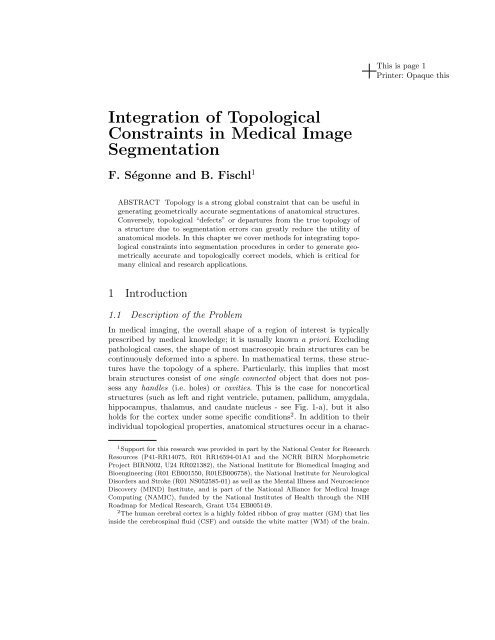
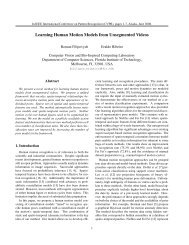
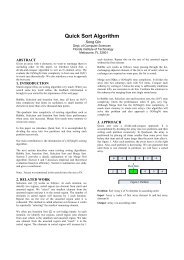
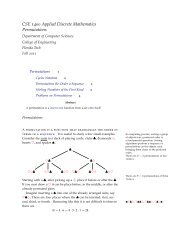
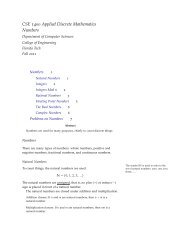
![{ public static void main (String[] args) { System.out.println (](https://img.yumpu.com/49719541/1/190x143/-public-static-void-main-string-args-systemoutprintln-hello-.jpg?quality=85)
